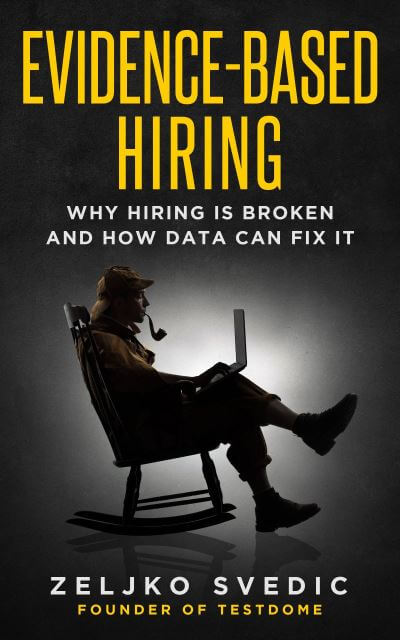CHAPTER 2: The Current Model Doesn’t Work Because We’re All Biased
Before we can fix what’s broken, we first need to understand why it’s broken and who broke it.
Let’s talk about intelligence for a moment. Try this brain-teaser:
A father and son are in a horrible car crash, which kills the father. The son is rushed to the hospital. Just as he’s about to go under the knife, the surgeon says, “I can’t operate—this boy is my son!”
How is this possible?
If you haven’t seen this puzzle, take no more than a minute to try and solve it. The answer is on the next page…
The answer is simple: the surgeon is the boy’s mother. Were you able to solve it, and how many seconds did it take you to find the answer?
This is a classic question to test for gender bias. When we imagine a surgeon, we tend to imagine a male surgeon. Research from Boston University shows only 14% of students are able to come up with the answer1. Students that identified as feminists were still only able to find the solution 22% of the time.
You might think that you don’t have a gender or race bias, but even people in an in-group can be biased against its other members. Psychologists Kenneth and Mamie Clark created “the doll tests”, where kids are given a choice of a few dolls with different skin tones2. African-American kids overwhelmingly choose white dolls, as they “are prettier” and “better.”
As adults, we can’t avoid our biases either. Whether on a date or in an interview, the first thing that you notice is the other person’s physical appearance. It’s regrettable, but it’s human nature. We are not biased because we are dumb or uneducated. We are biased because with a lack of other information, we resort to stereotypes to make a decision. That is usually intuitive and can’t be turned off. If you think you can, I invite you not to think of a polar bear. Ironic process theory states3 that deliberate attempts to suppress certain thoughts make them more likely to surface.
Screening by Proxy
When hiring, as we already discussed, we have a lack of information, and so we are likely to use proxies to make a decision:
If a person is good at X (proxy), they are probably going to be good at Y (work).
Popular screening proxies are; school prestige, years of work experience, having worked at a big name company, eloquence, self-confidence, appearance, punctuality, gender, and race.
Screening by proxy is not necessarily bad. When hiring, we must use proxies because we can’t know the results4.
There are better and worse proxies. Good proxies are supported by research and shown to lead to good hires—they’re signals, while other proxies are just noise.
Screening discrimination probably won’t be based on a single proxy. We tend to interview with a preconceived idea of what a stereotypical candidate for that position should look like. Let’s say I am hiring a surgeon and all candidates have equal qualifications. One candidate walks in for an interview and he is a tall, Caucasian male with a deep, assertive voice. He’s missing the stethoscope around his neck, but otherwise he’s the epitome of every TV ER doctor. When interviewing him, I’m reassured by this. The next candidate walks in and I’m surprised to see it’s a young woman with short, dyed blond hair, and a tattoo on her neck. She looks more like a punk-rock singer than a surgeon. The interview goes well, and her answers are good, but something in my gut just doesn’t feel right. A hidden part of my brain is telling me it has never seen a surgeon like this. Situations that are familiar make us relaxed, while situations that are unfamiliar make us stressed and uncertain. Meanwhile, another part of my brain is evaluating my social situation—what will my coworkers say if I pick such a strange candidate? Is it worth the risk?
This is how our hidden biases work:
If we don’t have enough information to decide between applicants, our emotions tell us to go with the most stereotypical candidate.
I am probably destined to choose the ER guy over the punk girl. It’s the safer choice. What do you think you would do?
Not only do people judge by proxy, they often judge by proxy of a proxy. For example, a common belief is that people who are nice to their dogs are nice to other people5. Double-proxy reasoning states that, if someone has a dog, they must have empathy and, therefore, they will be nice to everyone. A similar double proxy is that, if a man has a loving wife, he can’t be all that bad a human.
Sounds quite reasonable until you remember the guy in the next figure.

By all historical accounts, Hitler loved his dog Blondi and was a strong supporter of animal rights. The Nazis introduced many animal welfare laws, offenders of which were sent to concentration camps7. Hitler, himself, was a vegetarian8 and was planning to ban slaughterhouses after WWII because of animal cruelty. He was also a non-smoker and non-drinker. Hitler’s mistress, Eva Braun, loved him so much that she decided to share his faith. They got married in his underground bunker and, 40 hours later, they committed suicide together9.
We can trust that all these proxies didn’t give people a reliable read on Mr. Hitler, nor have we updated these proxies since. So, while there are slightly more women than men in the US, no woman has ever been elected president, neither has a Hispanic or Asian minority. These demographics, which represent 62% of society, have not been elected once in 58 presidential elections.
So, who gets votes? Well, all American presidents for the past 130 years, except one, had owned a dog10. All but two of them were married11. All but two were Christians12. All, except one, were white. No matter what people say they look for in a head of state, an older, white, religious male with a wife and a dog fits a stereotype of a good president.
The problem is not restricted to the average voter. When Albert Einstein graduated from ETH Zurich in 1900, both his professors of mathematics and physics refused to give him a job recommendation13. The professor of mathematics refused because Einstein skipped his math lectures. The professor of physics refused because Einstein called his lectures “outdated” and questioned why he didn’t teach modern theories. As a result, Einstein was the only one in his class of students who couldn’t find employment in his field. He was forced to work at a patent office, and only managed to get an academic job a few years after he published his special theory of relativity. If the main criterion for examination had been creating original physics papers, or if the testing of students was blind, it’s likely a young Albert could have shown what he had to offer. In the case of Einstein, his professors used a “did the student attend my lectures” proxy and a “did the student like my course” proxy.
It is important to realize that proxies are just proxies and they should not be taken into account without data proving their validity.
Proxies and Biases in Hiring
Let’s take a look at places where biases and incorrect proxies can derail a typical hiring process:
Résumé screening - résumés are stuffed with proxies which candidates have intentionally included to look better, and that can trip our biases. Candidates of the right age will put their birthdate, others will omit it. Attractive candidates will attach their photo, the others will not. Prominent schools and well-known companies will be put at the top, even if the candidate was not the best student or employee there. Some candidates’ “personal achievements” sections will list charity work, Boy Scouts, Mensa membership, or other proxies-of-a-proxy.
The telephone interview - here, we tend to ask candidates very simple questions which are related to their previous experience and résumé. Delivered this way, it is not a knowledge or work test. Instead, it’s more of a short communication skills test that extroverts will ace. Even if the job requires communication skills, this doesn’t mean a phone call is a good proxy for work-specific communication.
Interviews - Most interviewers base their decisions on subjective feelings, which research shows are largely influenced by a 20-second first impression14.
Giving candidates tasks on interviews - here, bias is introduced when we watch a candidate solve a task. It immediately puts them under pressure, which we often want for our “performs well under stress” proxy, but it’s an artificial situation that they’re unlikely to be faced with when hired.
Standardized testing - although standardized testing is good, bias is introduced when we decide what to test. If we ask questions that require experience, then we bias against young graduates that may otherwise be great employees. If we administer verbal reasoning tests, we bias against non-native speakers.
We can’t rely on hunches or biases when hiring. We need to be both methodical and scientific. Fortunately, there is a great deal of hiring research that tells us which methods work and which, well, don’t.

